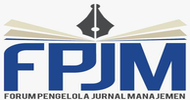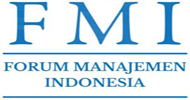PENGARUH EXPERIENTIAL MARKETING DAN PHYSICAL EVIDENCE TERHADAP IMPULSE BUYING
DOI:
https://doi.org/10.32832/manager.v5i5.8704Keywords:
Experiential Marketing, Physical Evidence, Impulse Buying.Abstract
Abstract
The research is conducted to determine the Impact of Experiential Marketing and Physical Evidence on Impulse Buying at Hypermart Branch of Gorontalo. The data analysis technique employs multiple regression analysis in which the research samples are 71 people that have been determined through non-probability sampling. The research applies quantitative method. The research finding denotes that whether partially or simultaneously, the Experiential Marketing and Physical Evidence possess a positive and significant impact on impulse buying at Hypermart Branch of Gorontalo. In other words, the finding confirms that a better application of experiential marketing and physical evidence will increase the impulse buying at Hypermart Branch of Gorontalo.
Penelitian ini bertujuan untuk mengetahui Pengaruh Experiential Marketing dan Physical Evidence Terhadap impulse buying pada Hypermart Cabang Gorontalo. Teknik analisis data dalam penelitian ini menggunakan analisis regresi berganda. Besarnya sampel dalam penelitian ini berjumlah 71 orang dengan teknik pengambilan sampel non probability sampling. Metode yang digunakan dalam penelitian ini adalah metode kuantitatif. Hasil penelitian menunjukan bahwa Experiential Marketing dan Physica Evidence secara parsial dan simultan berpengaruh positif dan signifikan terhadap impulse buying pada Hypermart Cabang Gorontalo. Hal ini menunjukan jika semakin baik experiential marketing dan physical evidence yang diterapkan maka impulse buying pada Hypermart Cabang Gorontalo juga akan ikut meningkat.
References
Andreani, Fransisca. 2007. Experiential Ma rketing. Jurnal (https://jurnalpemasa ran.petra.ac.id/index.php/mar/article
/view/17009)
Chou, H. J. 2009. The Effect of Experiential and Relationship Marketing on Customer Value: A Case Study of International American Casual Dining Chains in Taiwan. Social Behavior and Personality, 37 (7), 993-1008)
Lopiyoadi Hamdani A. Rambat, 2018, Manajemen Pemasaran Jasa, cetakan pertama, edisi kedua, Penerbit : Salemba Empat, Jakarta
Nichols, J., Li, F., Roslow, S., Kranendonk,
C. And Mandakovic, T (2001), "Inter-American prespective from mall shopper: Chile-united states ",Journal of global marketing, Vol.15 No. 1,pp.87-103
Nielsen, A.C.. 2018. Survey of Consumer Behavior and Perception toward Modern and Traditional Trade Channels, Departemen Perdagangan Republik Indonesia : Jakarta.
Sahid, Roynal Abdul and , Dr. Anton Agus Setyawan, M.Si. 2019. Faktor- Faktor yang Mendorong Pembelian Impulsif pada Produk Makanan. Skripsi thesis, Universitas Muhammadiyah Surakarta.
Schiffman, Leon G. dan Leslie Lazar Kanuk. 2010. Consumer Behavior. Tenth. Edition. Pearson Education
Schmitt, B. H..2009. Experiential Marketing : How to Get Customers to Sense, Feel, Think, Act, and Relate to Your Company and Brands. New York: Free Press.
Setiawan, Budhi Yadi. 2016. Konsumen Indonesia Sangat Sembrono. Marketing
Smilansky, Shaz. 2009. Experiential Marketing: A Practical Guide to Interactive Brand Experiences. London and Philadelphia: Kogan Page.
Anitia Agusanti , Zainal Abidin Umar , Hapsawati Taan
Sugiyono. 2011. Metode Penelitian kuantitatif kualitatif dan R&D. Bandung: Alfabeta
Taan, Hapsawati. 2017. Buku Perilaku Konsumen Dalam Berbelanja. Zahir Publishing . UNG. Gorontalo.
Wang, C. Y., & Lin, C. H. (2010). A Study of The Effect of TV Drama on Relationships among Tourist' Experiential Marketing, Experiential Value and Satisfaction. International Jounal of Organizational Innovation,2 (3), 107-123.














